Backgrounder
The Chinese Animation Dream: Making Made-in-China ‘Donghua’ Great Again
The Chinese animation industry is a much-discussed topic in the media and on Weibo. Will China’s ‘donghua’ make a comeback?
Published
5 years agoon
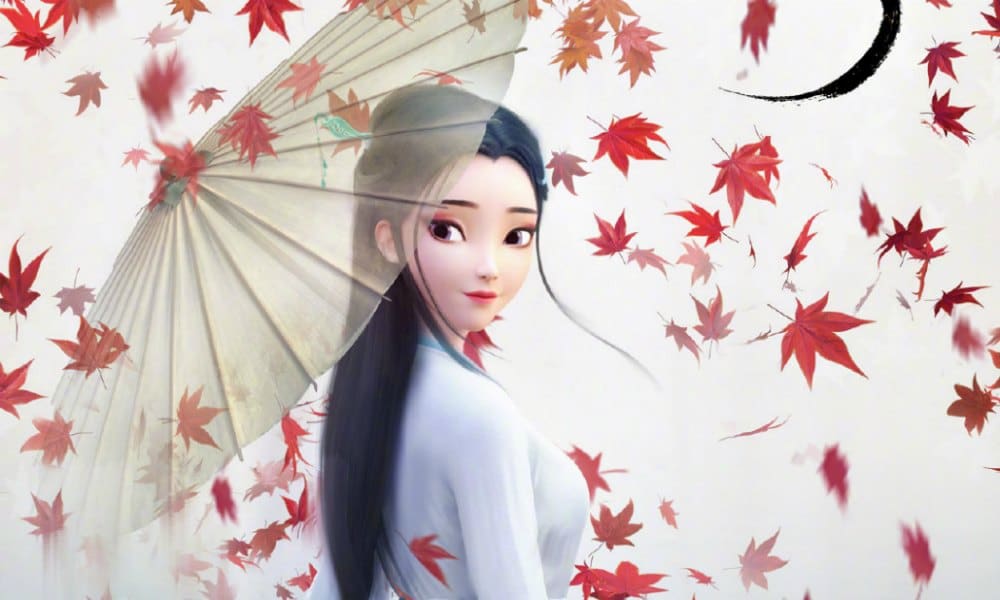
WHAT’S ON WEIBO ARCHIVE | PREMIUM CONTENT ARTICLE
First published
The Chinese animation industry is a hot topic these days. With China’s rising power and growing influence on global markets, its animation industry is lagging behind and still seems to have limited appeal for audiences inside and outside of mainland China. But there might be big changes on the horizon for the industry. Will the golden days of Chinese animation return? A short overview of the development of the Chinese animation market by What’s on Weibo.
The Chinese animated movie White Snake (白蛇:缘起), produced by Light Chaser Animation and Warner Bros, has been under the spotlight since its release on January 11. The fantasy animation, that has raked in 300 million yuan (±$44 million) at the box office, has triggered discussions in the media on the status quo and future of China’s animation industry.
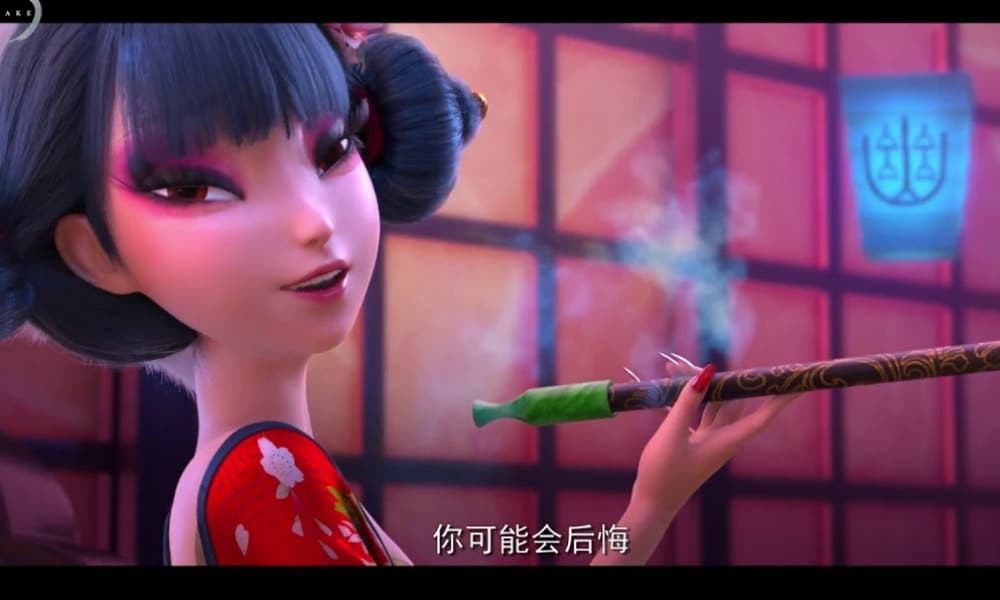
Although China is seeing a steady release of domestic animated films and series, there is still much room for improvement. Not only are many ‘donghua’ (动画) still lacking when it comes to quality and script, but the Chinese animation market is also facing fierce competition from the American and Japanese markets.
‘JAPANESE CULTURAL INVASION’
“Making China’s own animated heroes become examples for the Chinese youth”
A recent Foreign Policy article by Tanner Greer discusses the great popularity of Japanese manga (comics) and anime (cartoons) in the People’s Republic of China. The influence of Japanese popular culture in China is not necessarily appreciated by the Chinese government, which is concerned with maintaining a certain control over matters of cultural dissemination.
Since Japanese comics and films began to gain popularity in China in the early 1990s, there have been various developments that have shown the government’s dislike of the ‘Japanese cultural invasion’ in the country. To counter the impact of foreign animation/cartoon products, the authorities not only attempted to curb the inflow of these products but also to promote the production of its own China-made animations, that should reflect the ideals of the Party.
As early as 1995, President Jiang Zemin wrote a letter to the Shanghai Animation Film Studio (上海美术电影制片厂), writing that “inspiring people through excellent work is an important task of the cultural front,”1 and expressing his wishes that, “under the guidance of the Party’s literary and artistic principles, animation art workers will continue to release ideological, artistic and enjoyable art products, providing more and better spiritual sustenance for the youth and for children, making China’s own animated heroes become friends and examples for the [Chinese] youth” (1995; Saito 2017, 141).
Twenty-four year later, China’s animation industry has seen enormous growth but is still not as well-received by the Chinese public as Jiang had probably hoped for. Meanwhile, the demand for Japanese and other foreign products is still going strong: the animated movies that are in the top 3 of highest box office successes in mainland China are all foreign productions.
The 2018 Chinese animation The King of Football (足球王者) took approximately 60 million yuan ($8.8 million) to make, but became a commercial flop, raking in less than 1.8 million yuan ($267,000) at the box office (Yau 2018).
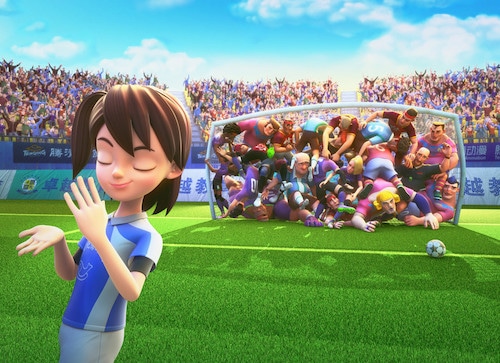
The King of Football turned out to be a flop at the box offices (image via PTT新聞).
The new animation White Snake is doing much better than the 2018 Football flop, and has made some Chinese state media note that the overall quality of domestically produced animation is steadily getting better, especially over the past few years. Yet, critics also note that despite several successes since 2015, the Chinese animation has yet to come out of its “low point” (China Daily Culture 2019).
GOLDEN AGE OF CHINESE ANIMATION
“Chinese films should be based on real Chinese traditions and stories”
If the current era marks a certain ‘low point’ in Chinese animation, then when was its ‘high’ performing time? The first so-called “golden age” of Chinese animation actually occurred in the 1957-1965 era. Long before that, in the 1920s, China’s renowned Wan brothers produced their first animated short, inspired by the success of Disney and the Fleischer brothers (Chen 2017, 175; Lent & Ying 2013, 20-22). It led to the production of China’s first fully-animated film Blood Money (血钱) in 1932.
The Nanjing-born Wan brothers (萬氏兄弟) are the twins Wan Laiming and Guchan (1900), Wan Chaochen (1906), and Wan Dihuan (1907), who are generally credited with starting Chinese animation. The first three names are the brothers who later joined the renowned Shanghai Animation Film Studio that was led by cartoonist Te Wei (特伟, 1915).
Te Wei is one of the major names in the Chinese School of Animation; he previously headed the Northeast Film Studio, that was founded in 1949.
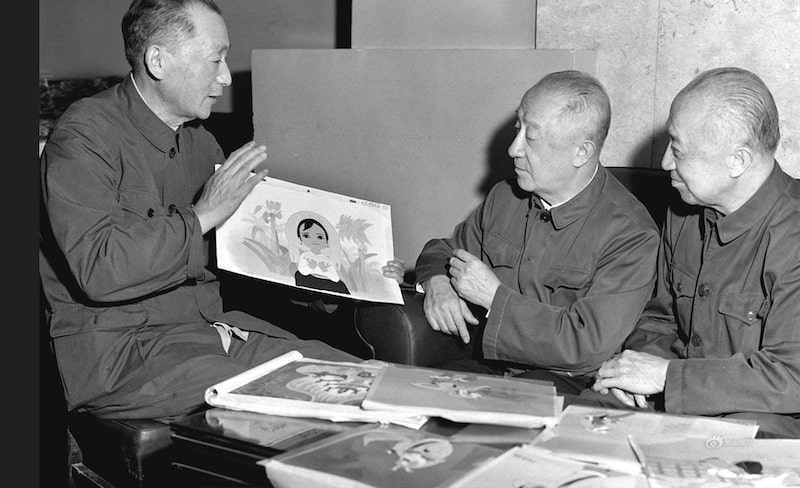
Three Wan brothers, with in the middle Wan Laiming, on the right Guchan, and Chaochen on the left (image via vmovier.com).
Although the Wan brothers were initially inspired by American animation, along with German and Russian styles, they soon focused on finding a more Chinese-oriented style in their work. In a 1936 interview, the brothers stated that Chinese films should be based on “real Chinese traditions and stories,” and should also be “educational” besides entertaining (Lent & Ying 2013, 22-23). Focusing more on Chinese artistic traditions was also something that was encouraged by Te Wei.
The Shanghai Animation Film studio started doing just that, and creators began committing themselves to learn from classical Chinese literature, paintings, and art, to build on truly Chinese animation canon that would incorporate a certain ‘national identity.’ For their 1956 24-minute animation The Conceited General (骄傲的将军), they even invited opera teachers to their work studio to learn from their Peking Opera movements and apply it to their animated characters (Chen 2017, 185; Lent & Ying 2013, 25-26).
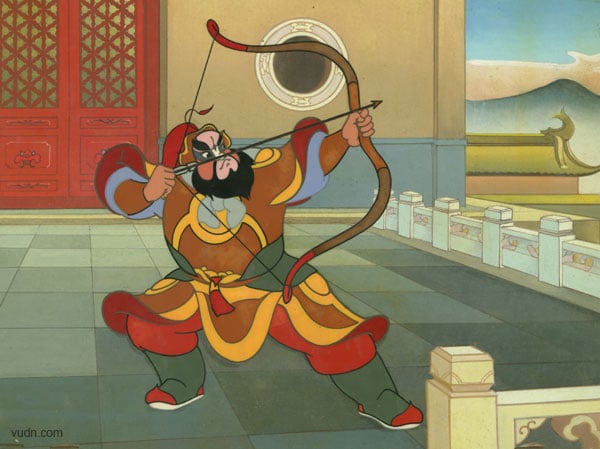
From the ‘Conceited General.’
The first color animation Why Crows Are Black (乌鸦为什么是黑的, 1956) became the first Chinese animation to be recognized internationally at the 1956 Venice Film Festival. The 1960 success of Where is Momma (小蝌蚪找妈妈) was followed by others, with the 1961/1964 Havoc in Heaven (大闹天宫) winning multiple awards, becoming one of China’s most-praised animation classics.
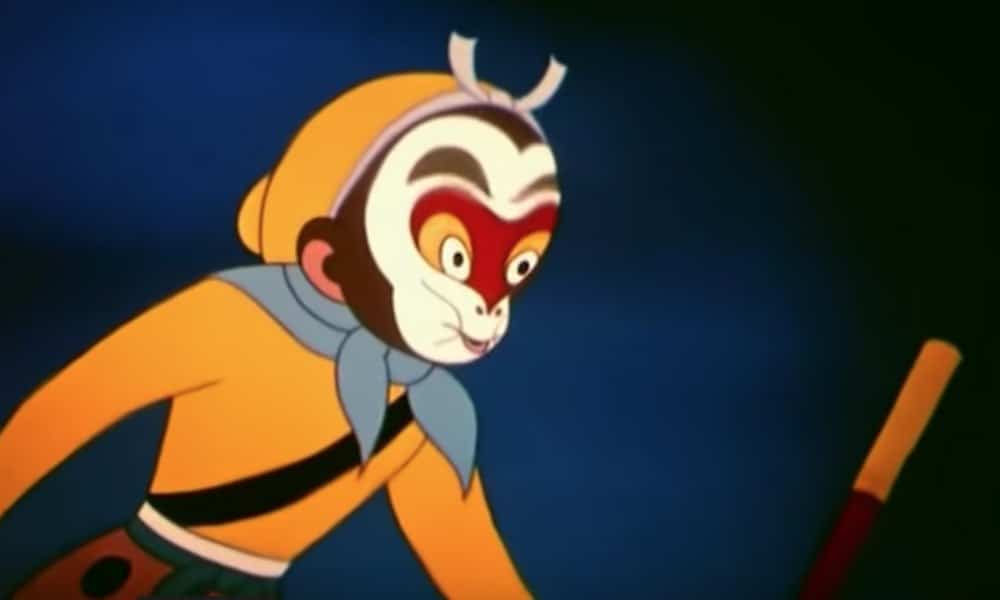
During the political turmoil of the Cultural Revolution (1966-1976), China’s animation industry suffered a huge blow and its first boom was halted. Starting from 1977 to the mid-1980s, a “second wave” of success followed, with new films that also carried that distinct style of Chinese animation; works such as the 1980s Three Monks (三个和尚) and the 1988 Feeling from Mountain and Water (山水情) are some example success stories within this second ‘golden age’ (Chen 2017).
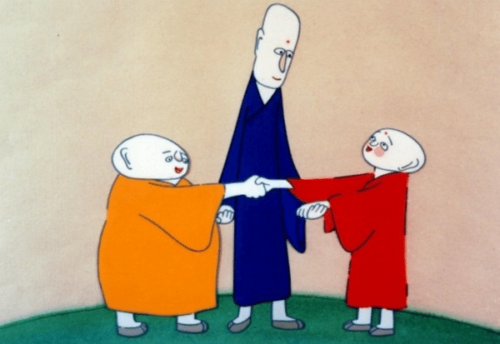
In a 2001 interview, Te Wei stated that there were multiple factors at play that contributed to the success of Chinese animation over the 1960-1980 period. The animation creators at the time, for example, were not pressured for deadlines and had unlimited creative time. There were enough financial resources to fund the studio (state support), little government control, a prosperous production system, and there were multiple generations of animators working together at the studio (Lent & Ying 2013, 27).
LOSING THE MAGIC TOUCH
“You can see Disney in it. But at least they tried”
So what happened to the golden days of Chinese animation? After the Mao era, in 1978, Deng Xiaoping famously initiated China’s Reform and Opening, starting the process which transformed the country and also had drastic consequences for China’s creative industries.
Following the emergence of the market economy, creators of Chinese animation had to focus more on the commercial value of their works. But while concentrating on consumer-based commerce, they also still had to make sure their productions were politically correct and in line with the (censorship) guidelines.
Starting from the 1990s, Chinese animation was officially defined as an “industry” and became a focus in the development of the national economy, with the government paying close attention (Chen 2017, 158; Wu 2017).
As described by John Lent and Xu Ying, animation studios started to struggle to support themselves and sped up productions to satisfy the rising domestic TV market, while also becoming “workstations” for overseas clients (2013, 27).
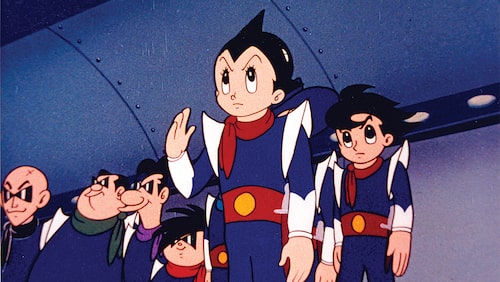
Japanese animations, such as Astro Boy, started getting more and more popular in mainland China since the early 1990s. (Image via Variety).
Although the number of productions went up, the high production pressure affected creativity and the artistic quality of Chinese animation.
Meanwhile, the market came to be dominated by imported, sometimes pirated, foreign animations. Astro Boy, Doraemon, Chibi Maruko-chan and other Japanese popular culture became more influential among Chinese youth in the 1990s. This also changed viewers’ preferences and aesthetic standards, and many Chinese animations adopted more Japanese or American styles in their creations (Ho 2018, 167; Liu 2007, 29).
With the rise of the internet in China, the inflow of (pirated) animations and cartoons from outside of China, and their major impact, began to become much harder to combat.
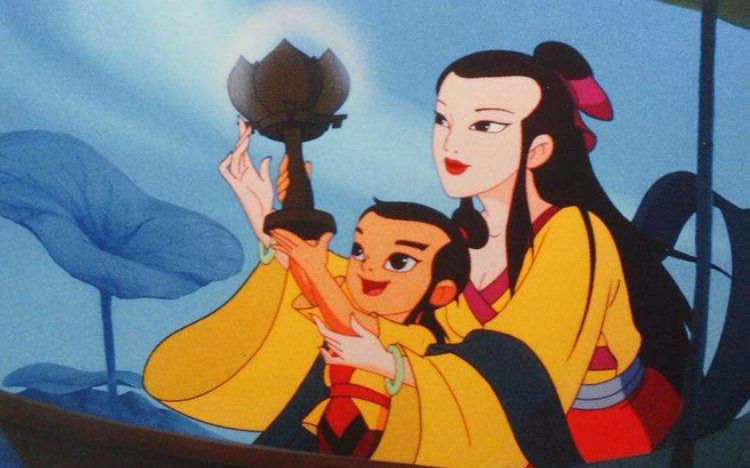
Some films, such as the 1999 Lotus Lantern (宝莲灯) by Shanghai Animation Film Studio still succeeded in becoming a high-quality commercial success, although Chinese cartoonist Te Wei did note: “You can see Disney in it. But at least they tried” (Lent & Ying 2017).
THE RISE OF CHINA’S ANIMATION?
“Chinese animations keep on getting better and better, and it makes me feel proud”
For the past few years, especially since the propagated concept of the ‘Chinese Dream’ has popularized within Chinese society, an idea that focuses on ‘national rejuvenation,’ the ‘comeback’ of Chinese animation has become a much-discussed topic in state media and on social media.
The main idea disseminated by state media and government, is that Chinese donghua (动画, animation) should be developed with specific Chinese characteristics, should not blindly follow its (foreign) competitors, and should propagate Chinese culture and socialist values. The slogan “Revive the Country’s Creativity” (振兴国创) is repeated in dozens of these articles.
Some media claim that Chinese animation is no longer at its low point now, but has reached a stage of “adolescence” (Xinhua 2019). This resonates with earlier government articles proposing that China should become “an internationally strong animation country” by 2023 (GWP 2008).
There are many ways in which a ‘healthy development’ of China’s animation market is now promoted. Since 2010, animation companies in China enjoy certain tax benefits, there have been national award for the best animations since 2011, and since long there have been measures stipulating that a certain percentage of broadcasted animations must be China-made (Saito 2017).
A noteworthy animation that was released in 2018 is The Leader (领风者), a web series that focuses on the live and work of Karl Marx, commemorating the 200th anniversary of Marx’s birth.

The idea that was promoted with the release of The Leader was that promoting Chinese ‘mainstream values’ could also have a broad audience appeal, “as it can also be thrilling and attractive” (Global Times 2018).
The ‘rejuvenation’ of Chinese animation is not just a cultural and ideological project, there are economic motives at stake too; China’s animation industry is a multi-billion dollar industry.
Some media predict that 2019 might be a pivotal year for China’s animation. The successes of the 2015 Monkey King: Hero is Back (西游记之大圣归来), the 2016 Big Fish and Begonia (大鱼海棠) and the current White Snake film, might been strong indications that Chinese audiences are ready for more high-quality domestically produced animations that are based on classic literary works or historical themes, and incorporate Chinese traditional culture or socialist values.
The Legend of Nezha (哪吒之魔童降世), Jiang Ziya (姜子牙), and Phoenix (凤凰) are some of the much anticipated made-in-China animated movies to come out this year.
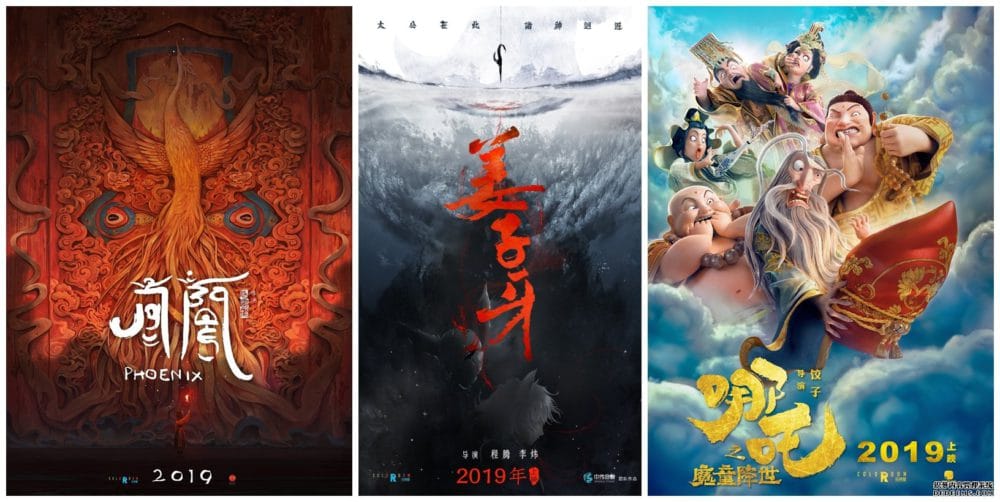
On Weibo, Chinese animations are a daily hot topic, and so is their overall development. The phrase “I support made-in-China animations” frequently pops up, but so do the questions (“when will our animations rise?”) and the criticism.
“They are in the stage of imitating and exaggerating to keep up with international standards,” some say: “But their scripts are still unclear and somewhat embarrassing.”
“The dialogues are still their main problem,” others say. Many people on social media express this idea of ‘China-made animations’ being of a certain low quality, although there are also many who say their views have changed after seeing White Snake in the cinema.
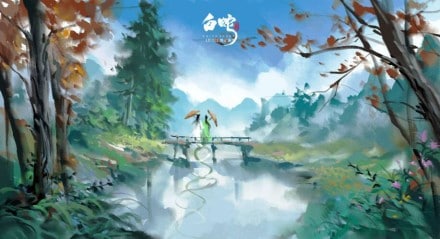
White Snake movie poster
Some commenters write that “Chinese animations keep on getting better and better, and it makes me feel proud.” This idea of a strong Chinese animation market also triggers patriotic reactions elsewhere on Weibo.
Many netizens, however, still allege that the animations made during the “golden years” of China’s 1960s to 1980s were simply the best. “In those years, the animations they produced were just all classics. Nowadays, I can’t even bear to watch anymore.”
Others agree, writing: “They were just so Chinese.”
By Manya Koetse
References:
CGW Central Government Web Portal. 2008. “文化部发布关于扶持我国动漫产业发展的若干意见.” Gov.cn http://www.gov.cn/gzdt/2008-08/19/content_1075077.htm [2.10.19].
Chen, Shaoping. 2017. “Industrial transformation in Chinese animation cinema (1995–2015).” New Cinemas: Journal of Contemporary Film 15(2): 157-174.
Chen, Yuanyuan. 2017. “Old or New Art> Rethinking Classical Animation.” Journal of Chinese Cinemas 11 (2): 175-188.
China Culture Daily 中国文化报. 2019. “[国产动画2018:正在蓬勃生长 期待“冲破天际”]. People’s Daily, January 8. http://ent.people.com.cn/n1/2019/0108/c1012-30509797.html [1.26.19].
Jiang Zemin. 1995. “为少儿提供更多更好的精神食粮 [Providing the youth with more and better spiritual sustenance].” 中国共产党新闻 [News of the Communist Party of China], August 28. http://dangshi.people.com.cn/GB/242358/242773/242777/17735177.html [Jan 25 2019].
Global Times. 2018. “Nation to release first animation on Karl Marx.” Global Times 19 Dec http://www.globaltimes.cn/content/1132690.shtml [10.2.19].
Greer, Tanner. 2019. “Super Patriotic Anime Youth Wars!” Foreign Policy, January 23. https://foreignpolicy.com/2019/01/23/super-patriotic-anime-youth-wars-china-japan-pop-culture/ [Jan 25 2019].
Ho, Wai-Chung. 2018. Culture, Music Education, and the Chinese Dream in Mainland China. Singapore: Springer.
Lent, John A. and Xu Ying. 2013. “Chinese Animation: An historical and contemporary analysis.” Journal of Asian Pacific Communication 23(1): 19-40.
– 2017. Comics Art in China. Jackson: University Press of Mississippi.
Liu, Qing Fang. 2007. “When Chinese Animations meet GLobalization.” Master Thesis, Cultural Economics and Cultural Entrepreneurship, Erasmus University Rotterdam.
Saito, Asako P. 2017. “Moe and Internet Memes: The Resistance and Accommodation of Japanese Popular Culture in China.” Cultural Studies Review 23(1), 136-150.
Yau, Elaine. 2018. “Why Chinese animated films do so badly in China compared to Western ones.” South China Morning Post, October 17. https://www.scmp.com/culture/film-tv/article/2168973/why-chinese-animated-films-do-so-badly-china-compared-western-ones
Wu, Weihua. 2017. Chinese Animation, Creative Industries, and Digital Culture. London: Routledge.
Xinhua. 2019. “不再低幼 国漫进入“青春期”.” Xinhua Feb 3rd http://www.xinhuanet.com/ent/2019-02/03/c_1124081879.htm [10.2.19].
1“用优秀的作品鼓舞人,是文化战线的重要任务”
*” 当年的动画片和电影几乎部部经典!现在的基本上都不能看了。。”
*”那时候的动画片都很中国”
Other relevant links:
http://www.p5w.net/news/cjxw/201812/t20181219_2237399.htm
http://www.xinhuanet.com/politics/2019-01/03/c_1123941747.htm
http://www.xinhuanet.com/ent/2019-02/03/c_1124081879.htm
http://www.chinanews.com/cul/2018/05-12/8512351.shtml
http://media.people.com.cn/n1/2019/0125/c40606-30590294.html
Spotted a mistake, typo, or want to add something? Please let us know through email.
©2019 Whatsonweibo. All rights reserved. Do not reproduce our content without permission – you can contact us at info@whatsonweibo.com
Manya Koetse is the founder and editor-in-chief of whatsonweibo.com. She is a writer, public speaker, and researcher (Sinologist, MPhil) on social trends, digital developments, and new media in an ever-changing China, with a focus on Chinese society, pop culture, and gender issues. She shares her love for hotpot on hotpotambassador.com. Contact at manya@whatsonweibo.com, or follow on Twitter.

Backgrounder
“Oppenheimer” in China: Highlighting the Story of Qian Xuesen
Qian Xuesen is a renowned Chinese scientist whose life shares remarkable parallels with Oppenheimer’s.
Published
8 months agoon
September 16, 2023By
Zilan Qian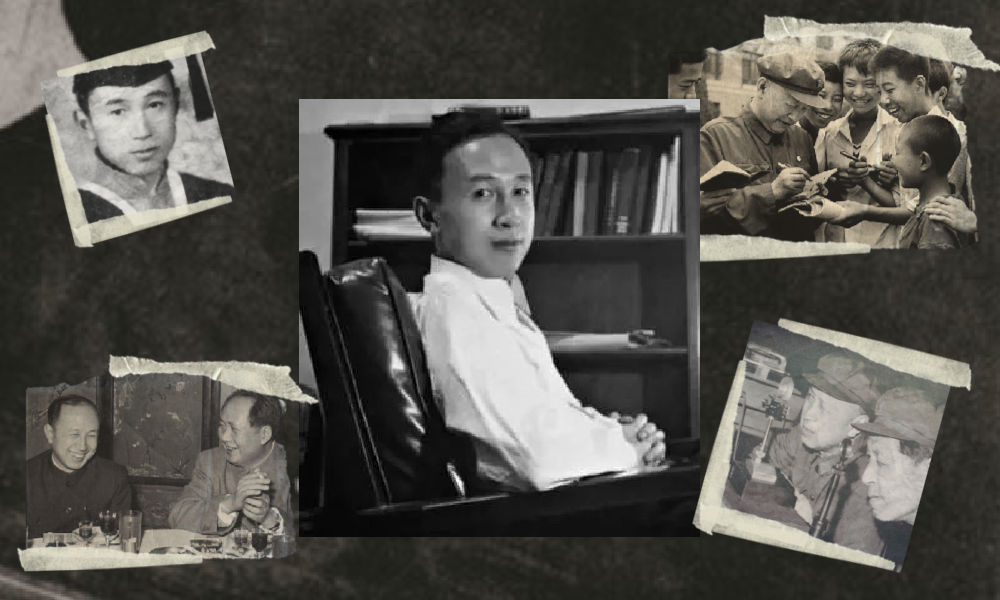
They shared the same campus, lived in the same era, and both played pivotal roles in shaping modern history while navigating the intricate interplay between science and politics. With the release of the “Oppenheimer” movie in China, the renowned Chinese scientist Qian Xuesen is being compared to the American J. Robert Oppenheimer.
In late August, the highly anticipated U.S. movie Oppenheimer finally premiered in China, shedding light on the life of the famous American theoretical physicist J. Robert Oppenheimer (1904-1967).
Besides igniting discussions about the life of this prominent scientist, the film has also reignited domestic media and public interest in Chinese scientists connected to Oppenheimer and nuclear physics.
There is one Chinese scientist whose life shares remarkable parallels with Oppenheimer’s. This is aerospace engineer and cyberneticist Qian Xuesen (钱学森, 1911-2009). Like Oppenheimer, he pursued his postgraduate studies overseas, taught at Caltech, and played a pivotal role during World War II for the US.
Qian Xuesen is so widely recognized in China that whenever I introduce myself there, I often clarify my last name by saying, “it’s the same Qian as Qian Xuesen’s,” to ensure that people get my name.
Some Chinese blogs recently compared the academic paths and scholarly contributions of the two scientists, while others highlighted the similarities in their political challenges, including the revocation of their security clearances.
The era of McCarthyism in the United States cast a shadow over Qian’s career, and, similar to Oppenheimer, he was branded as a “communist suspect.” Eventually, these political pressures forced him to return to China.
Although Qian’s return to China made his later life different from Oppenheimer’s, both scientists lived their lives navigating the complex dynamics between science and politics. Here, we provide a brief overview of the life and accomplishments of Qian Xuesen.
Departing: Going to America
Qian Xuesen (钱学森, also written as Hsue-Shen Tsien), often referred to as the “father of China’s missile and space program,” was born in Shanghai in 1911,1 a pivotal year marked by a historic revolution that brought an end to the imperial dynasty and gave rise to the Republic of China.
Much like Oppenheimer, who pursued further studies at Cambridge after completing his undergraduate education, Qian embarked on a journey to the United States following his bachelor’s studies at National Chiao Tung University (now Shanghai Jiao Tong University). He spent a year at Tsinghua University in preparation for his departure.
The year was 1935, during the eighth year of the Chinese Civil War and the fourth year of Japan’s invasion of China, setting the backdrop for his academic pursuits in a turbulent era.
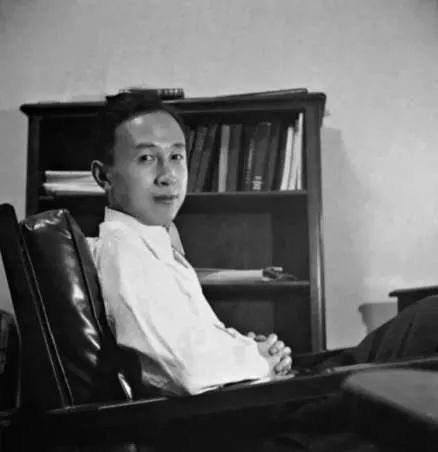
Qian in his office at Caltech (image source).
One year after arriving in the U.S., Qian earned his master’s degree in aeronautical engineering from the Massachusetts Institute of Technology (MIT). Three years later, in 1939, the 27-year-old Qian Xuesen completed his PhD at the California Institute of Technology (Caltech), the very institution where Oppenheimer had been welcomed in 1927. In 1943, Qian solidified his position in academia as an associate professor at Caltech. While at Caltech, Qian helped found NASA’s Jet Propulsion Laboratory.
When World War II began, while Oppenheimer was overseeing the Manhattan Project’s efforts to assist the U.S. in developing the atomic bomb, Qian actively supported the U.S. government. He served on the U.S. government’s Scientific Advisory Board and attained the rank of lieutenant colonel.

The first meeting of the US Department of the Air Force Scientific Advisory Board in 1946. The predecessor, the Scientific Advisory Group, was founded in 1944 to evaluate the aeronautical programs and facilities of the Axis powers of World War II. Qian can be seen standing in the back, the second on the left (image source).
After the war, Qian went to teach at MIT and returned to Caltech as a full-time professor in 1949. During that same year, Mao Zedong proclaimed the establishment of the People’s Republic of China (PRC). Just one year later, the newly-formed nation became involved in the Korean War, and China fought a bloody battle against the United States.
Red Scare: Being Labeled as a Communist
Robert Oppenheimer and Qian Xuesen both had an interest in Communism even prior to World War II, attending communist gatherings and showing sympathy towards the Communist cause.
Qian and Oppenheimer may have briefly met each other through their shared involvement in communist activities. During his time at Caltech, Qian secretly attended meetings with Frank Oppenheimer, the brother of J. Robert Oppenheimer (Monk 2013).
However, it was only after the war that their political leanings became a focal point for the FBI.
Just as the FBI accused Oppenheimer of being an agent of the Soviet Union, they quickly labeled Qian as a subversive communist, largely due to his Chinese heritage. While the government did not succeed in proving that Qian had communist ties with China during that period, they did ultimately succeed in portraying Qian as a communist affiliated with China a decade later.
During the transition from the 1940s to the 1950s, the Cold War was underway, and the anti-communist witch-hunts associated with the McCarthy era started to intensify (BBC 2020).
In 1950, the Korean War erupted, with the People’s Republic of China (PRC) joining North Korea in the conflict against South Korea, which received support from the United States. It was during this tumultuous period that the FBI officially accused Qian of communist sympathies in 1950, leading to the revocation of his security clearance despite objections from Qian’s colleagues. Four years later, in 1954, Robert Oppenheimer went through a similar process.
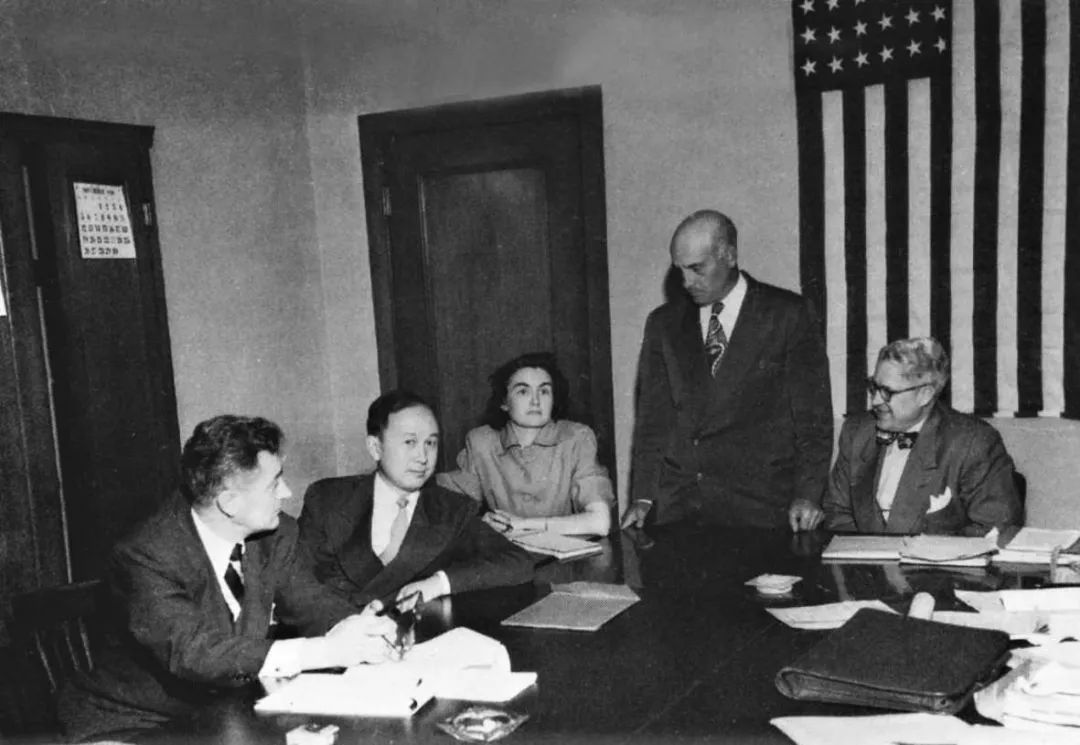
The 1950’s security hearing of Qian (second left). (Image source).
After losing his security clearance, Qian began to pack up, saying he wanted to visit his aging parents back home. Federal agents seized his luggage, which they claimed contained classified materials, and arrested him on suspicion of subversive activity. Although Qian denied any Communist leanings and rejected the accusation, he was detained by the government in California and spent the next five years under house arrest.
Five years later, in 1955, two years after the end of the Korean War, Qian was sent home to China as part of an apparent exchange for 11 American airmen who had been captured during the war. He told waiting reporters he “would never step foot in America again,” and he kept his promise (BBC 2020).
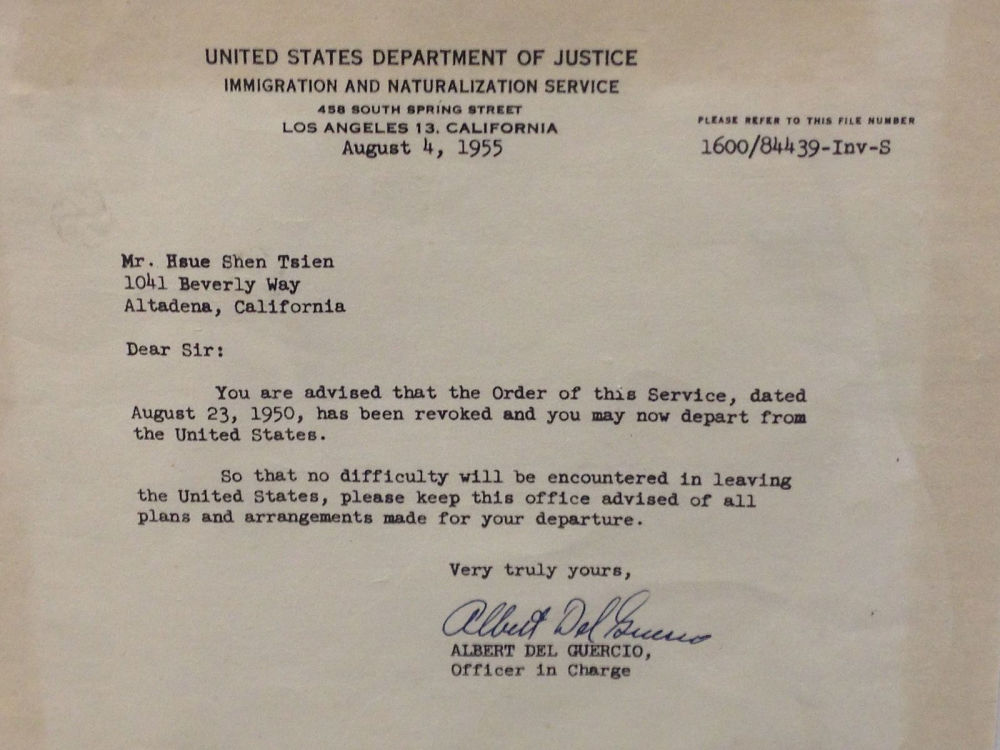
A letter from the US Immigration and Naturalization Service to Qian Xuesen, dated August 4, 1955, in which he was notified he was allowed to leave the US. The original copy is owned by Qian Xuesen Library of Shanghai Jiao Tong University, where the photo was taken. (Caption and image via wiki).
Dan Kimball, who was the Secretary of the US Navy at the time, expressed his regret about Qian’s departure, reportedly stating, “I’d rather shoot him dead than let him leave America. Wherever he goes, he equals five divisions.” He also stated: “It was the stupidest thing this country ever did. He was no more a communist than I was, and we forced him to go” (Perrett & Bradley, 2008).
Kimball may have foreseen the unfolding events accurately. After his return to China, Qian did indeed assume a pivotal role in enhancing China’s military capabilities, possibly surpassing the potency of five divisions. The missile programme that Qian helped develop in China resulted in weapons which were then fired back on America, including during the 1991 Gulf War (BBC 2020).
Returning: Becoming a National Hero
The China that Qian Xuesen had left behind was an entirely different China than the one he returned to. China, although having relatively few experts in the field, was embracing new possibilities and technologies related to rocketry and space exploration.
Within less than a month of his arrival, Qian was welcomed by the then Vice Prime Minister Chen Yi, and just four months later, he had the honor of meeting Chairman Mao himself.
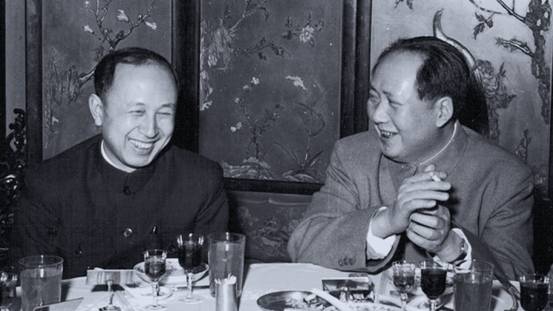
Qian and Mao (image source).
In China, Qian began a remarkably successful career in rocket science, with great support from the state. He not only assumed leadership but also earned the distinguished title of the “father” of the Chinese missile program, instrumental in equipping China with Dongfeng ballistic missiles, Silkworm anti-ship missiles, and Long March space rockets.
Additionally, his efforts laid the foundation for China’s contemporary surveillance system.
By now, Qian has become somewhat of a folk hero. His tale of returning to China despite being thwarted by the U.S. government has become like a legendary narrative in China: driven by unwavering patriotism, he willingly abandoned his overseas success, surmounted formidable challenges, and dedicated himself to his motherland.
Throughout his lifetime, Qian received numerous state medals in recognition of his work, establishing him as a nationally celebrated intellectual. From 1989 to 2001, the state-launched public movement “Learn from Qian Xuesen” was promoted throughout the country, and by 2001, when Qian turned 90, the national praise for him was on a similar level as that for Deng Xiaoping in the decade prior (Wang 2011).
Qian Xuesen remains a celebrated figure. On September 3rd of this year, a new “Qian Xuesen School” was established in Wenzhou, Zhejiang Province, becoming the sixth high school bearing the scientist’s name since the founding of the first one only a year ago.
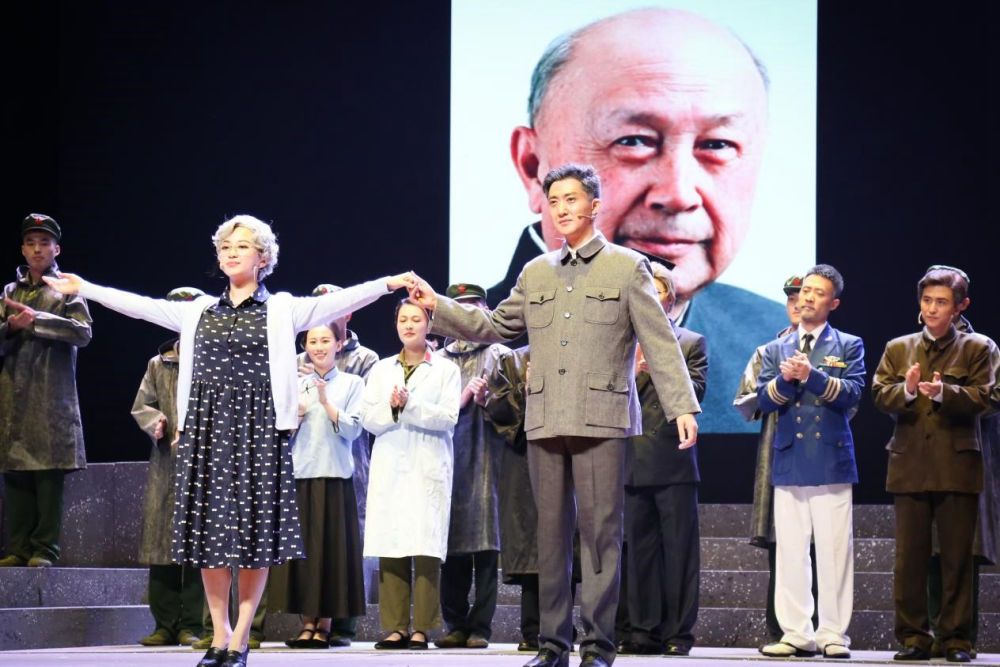
In 2017, the play “Qian Xuesen” was performed at Qian’s alma mater, Shanghai Jiaotong University. (Image source.)
Qian Xuesen’s legacy extends well beyond educational institutions. His name frequently appears in the media, including online articles, books, and other publications. There is the Qian Xuesen Library and a museum in Shanghai, containing over 70,000 artefacts related to him. Qian’s life story has also been the inspiration for a theater production and a 2012 movie titled Hsue-Shen Tsien (钱学森).2
Unanswered Questions
As is often the case when people are turned into heroes, some part of the stories are left behind while others are highlighted. This holds true for both Robert Oppenheimer and Qian Xuesen.
The Communist Party of China hailed Qian as a folk hero, aligning with their vision of a strong, patriotic nation. Many Chinese narratives avoid the debate over whether Qian’s return was linked to problems and accusations in the U.S., rather than genuine loyalty to his homeland.
In contrast, some international media have depicted Qian as a “political opportunist” who returned to China due to disillusionment with the U.S., also highlighting his criticism of “revisionist” colleagues during the Cultural Revolution and his denunciation of the 1989 student demonstrations.
Unlike the image of a resolute loyalist favored by the Chinese public, Qian’s political ideology was, in fact, not consistently aligned, and there were instances where he may have prioritized opportunity over loyalty at different stages of his life.
Qian also did not necessarily aspire to be a “flawless hero.” Upon returning to China, he declined all offers to have his biography written for him and refrained from sharing personal information with the media. Consequently, very little is known about his personal life, leaving many questions about the motivations driving him, and his true political inclinations.
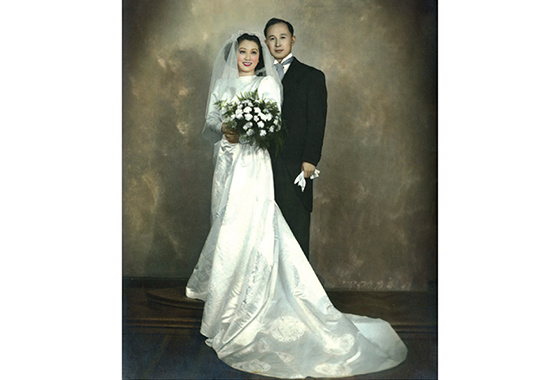
The marriage photo of Qian and Jiang. (Image source).
We do know that Qian’s wife, Jiang Ying (蒋英), had a remarkable background. She was of Chinese-Japanese mixed race and was the daughter of a prominent military strategist associated with Chiang Kai-shek. Jiang Ying was also an accomplished opera singer and later became a professor of music and opera at the Central Conservatory of Music in Beijing.
Just as with Qian, there remain numerous unanswered questions surrounding Oppenheimer, including the extent of his communist sympathies and whether these sympathies indirectly assisted the Soviet Union during the Cold War.
Perhaps both scientists never imagined they would face these questions when they first decided to study physics. After all, they were scientists, not the heroes that some narratives portray them to be.
Also read:
■ Farewell to a Self-Taught Master: Remembering China’s Colorful, Bold, and Iconic Artist Huang Yongyu
■ “His Name Was Mao Anying”: Renewed Remembrance of Mao Zedong’s Son on Chinese Social Media
By Zilan Qian
Follow @whatsonweibo
1 Some sources claim that Qian was born in Hangzhou, while others say he was born in Shanghai with ancestral roots in Hangzhou.
2The Chinese character 钱 is typically romanized as “Qian” in Pinyin. However, “Tsien” is a romanization in Wu Chinese, which corresponds to the dialect spoken in the region where Qian Xuesen and his family have ancestral roots.
This article has been edited for clarity by Manya Koetse
References (other sources hyperlinked in text)
BBC. 2020. “Qian Xuesen: The man the US deported – who then helped China into space.” BBC.com, 27 October https://www.bbc.com/news/stories-54695598 [9.16.23].
Monk, Ray. 2013. Robert Oppenheimer: A Life inside the Center, First American Edition. New York: Doubleday.
Perrett, Bradley, and James R. Asker. 2008. “Person of the Year: Qian Xuesen.” Aviation Week and Space Technology 168 (1): 57-61.
Wang, Ning. 2011. “The Making of an Intellectual Hero: Chinese Narratives of Qian Xuesen.” The China Quarterly, 206, 352-371. doi:10.1017/S0305741011000300
Get the story behind the hashtag. Subscribe to What’s on Weibo here to receive our newsletter and get access to our latest articles:
Spotted a mistake or want to add something? Please let us know in comments below or email us. First-time commenters, please be patient – we will have to manually approve your comment before it appears.
©2023 Whatsonweibo. All rights reserved. Do not reproduce our content without permission – you can contact us at info@whatsonweibo.com.
Backgrounder
Farewell to a Self-Taught Master: Remembering China’s Colorful, Bold, and Iconic Artist Huang Yongyu
Renowned Chinese artist and the creator of the ‘Blue Rabbit’ zodiac stamp Huang Yongyu has passed away at the age of 98. “I’m not afraid to die. If I’m dead, you may tickle me and see if I smile.”
Published
11 months agoon
June 15, 2023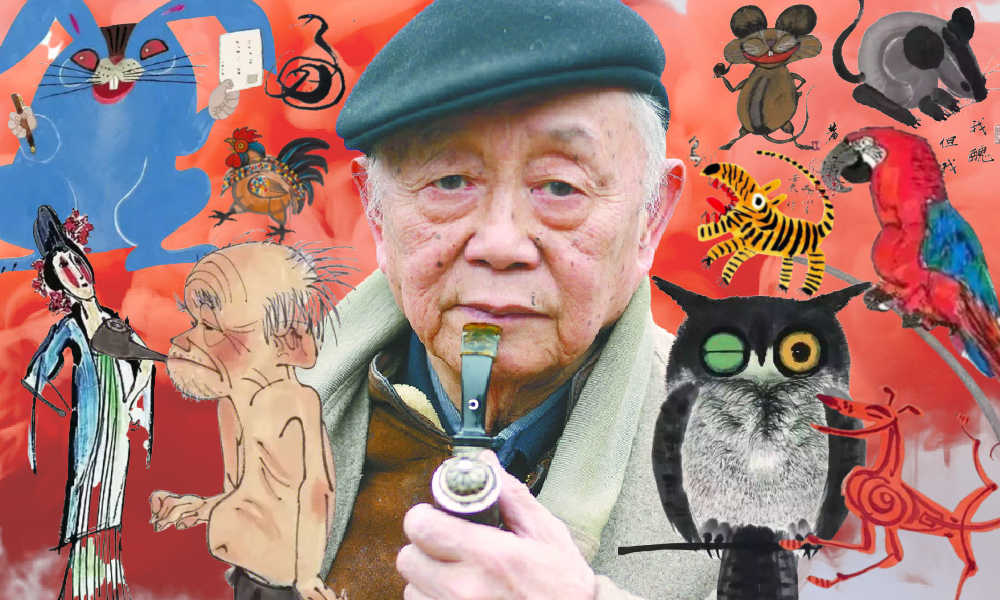
The famous Chinese painter, satirical poet, and cartoonist Huang Yongyu has passed away. Born in 1924, Huang endured war and hardship, yet never lost his zest for life. When his creativity was hindered and his work was suppressed during politically tumultuous times, he remained resilient and increased “the fun of living” by making his world more colorful.
He was a youthful optimist at old age, and will now be remembered as an immortal legend. The renowned Chinese painter and stamp designer Huang Yongyu (黄永玉) passed away on June 13 at the age of 98. His departure garnered significant attention on Chinese social media platforms this week.
On Weibo, the hashtag “Huang Yongyu Passed Away” (#黄永玉逝世#) received over 160 million views by Wednesday evening.
Huang was a member of the China National Academy of Painting (中国国家画院) as well as a Professor at the Central Academy of Fine Arts (中央美术学院).
Huang Yongyu is widely recognized in China for his notable contribution to stamp design, particularly for his iconic creation of the monkey stamp in 1980. Although he designed a second monkey stamp in 2016, the 1980 stamp holds significant historical importance as it marked the commencement of China Post’s annual tradition of releasing zodiac stamps, which have since become highly regarded and collectible items.
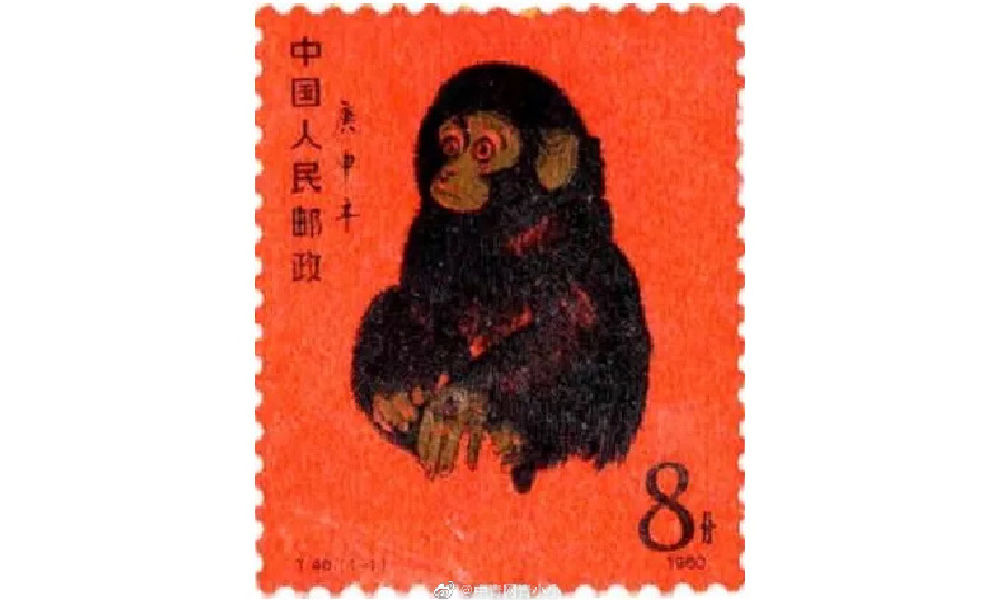
Huang’s famous money stamp that was issued by China Post in 1980.
The monkey stamp designed by Huang Yongyu has become a cherished collector’s item, even outside of China. On online marketplaces like eBay, individual stamps from this series are being sold for approximately $2000 these days.
Huang Yongyu’s latest most famous stamp was this year’s China Post zodiac stamp. The stamp, a blue rabbit with red eyes, caused some online commotion as many people thought it looked “horrific.”
Some thought the red-eyed blue rabbit looked like a rat. Others thought it looked “evil” or “monster-like.” There were also those who wondered if the blue rabbit looked so wild because it just caught Covid.
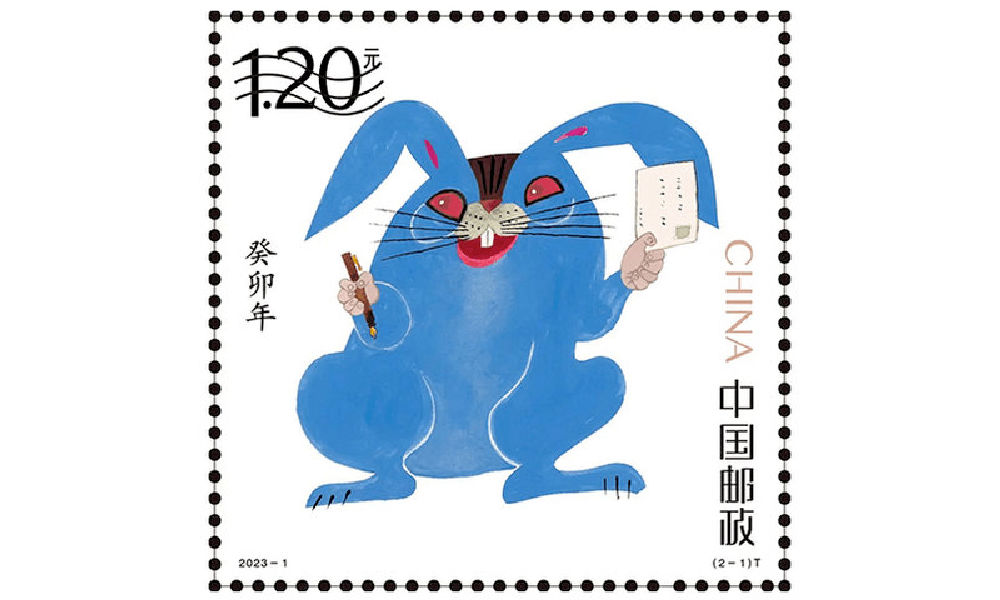
Huang’s (in)famous blue rabbit stamp.
Nevertheless, many people lined up at post offices for the stamps and they immediately sold out.
In light of the controversy, Huang Yongyu spoke about the stamps in a livestream in January of 2023. The 98-year-old artist claimed he had simply drawn the rabbit to spread joy and celebrate the new year, stating, “Painting a rabbit stamp is a happy thing. Everyone could draw my rabbit. It’s not like I’m the only one who can draw this.”
Huang’s response also went viral, with one Weibo hashtag dedicated to the topic receiving over 12 million views (#蓝兔邮票设计者直播回应争议#) at the time. Those defending Huang emphasized how it was precisely his playful, light, and unique approach to art that has made Huang’s work so famous.
A Self-Made Artist
“I’m ugly, but my mum likes me”
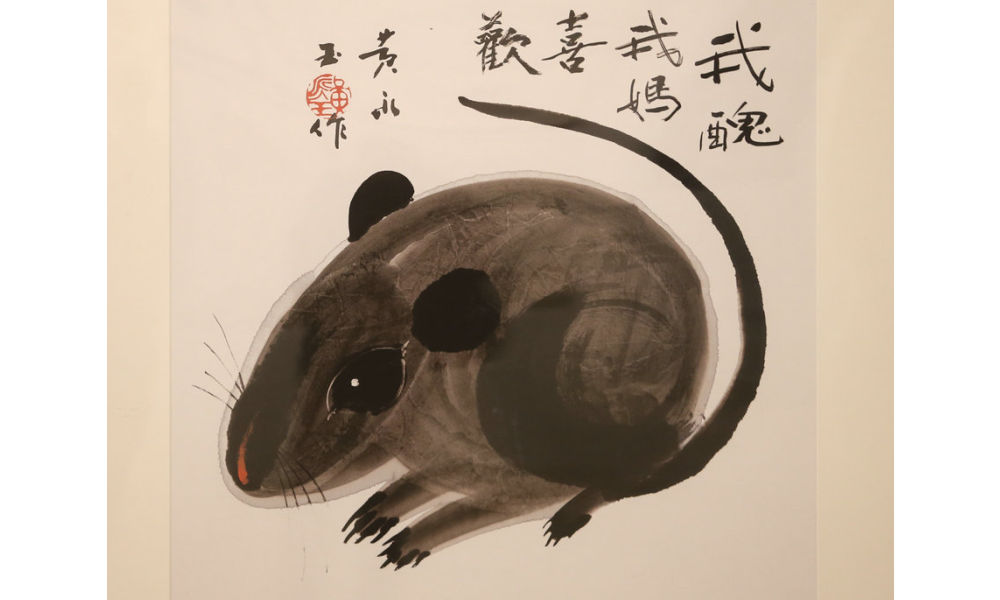
‘Ugly Mouse’ by Huang Yongyu [Image via China Daily].
Huang Yongyu was born on August 9, 1924, in Hunan’s Chengde as a native of the Tujia ethnic group.
He was born into an extraordinary family. His grandfather, Huang Jingming (黄镜铭), worked for Xiong Xiling (熊希齡), who would become the Premier of the Republic of China. His first cousin and lifelong friend was the famous Chinese novelist Shen Congwen (沈从文). Huang’s father studied music and art and was good at drawing and playing the accordion. His mother graduated from the Second Provincial Normal School and was the first woman in her county to cut her hair short and wear a short skirt (CCTV).
Born in times of unrest and poverty, Huang never went to college and was sent away to live with relatives at the age of 13. His father would die shortly after, depriving him of a final goodbye. Huang started working in various places and regions, from porcelain workshops in Dehua to artisans’ spaces in Quanzhou. At the age of 16, Huang was already earning a living as a painter and woodcutter, showcasing his talents and setting the foundation for his future artistic pursuits.
When he was 22, Huang married his first girlfriend Zhang Meixi (张梅溪), a general’s daughter, with whom he shared a love for animals. He confessed his love for her when they both found themselves in a bomb shelter after an air-raid alarm.
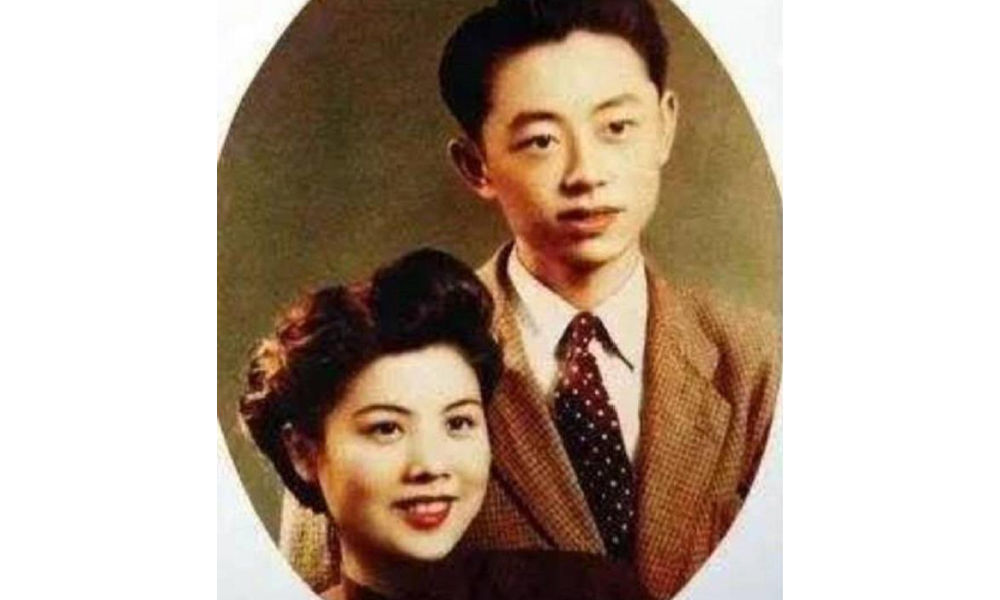
Huang and Zhang Meixi [163.com]
In his twenties, Huang Yongyu emerged as a sought-after artist in Hong Kong, where he had relocated in 1948 to evade persecution for his left-wing activities. Despite achieving success there, he heeded Shen Congwen’s advice in 1953 and moved to Beijing. Accompanied by his wife and their 7-month-old child, Huang took on a teaching position at the esteemed Central Academy of Fine Arts (中央美术学院).
The couple raised all kinds of animals at their Beijing home, from dogs and owls to turkeys and sika deers, and even monkeys and bears (Baike).
Throughout Huang’s career, animals played a significant role, not only reflecting his youthful spirit but also serving as vehicles for conveying satirical messages.
One recurring motif in his artwork was the incorporation of mice. In one of his famous works, a grey mouse is accompanied by the phrase ‘I’m ugly, but my mum likes me’ (‘我丑,但我妈喜欢’), reinforcing the notion that regardless of our outward appearance or circumstances, we remain beloved children in the eyes of our mothers.
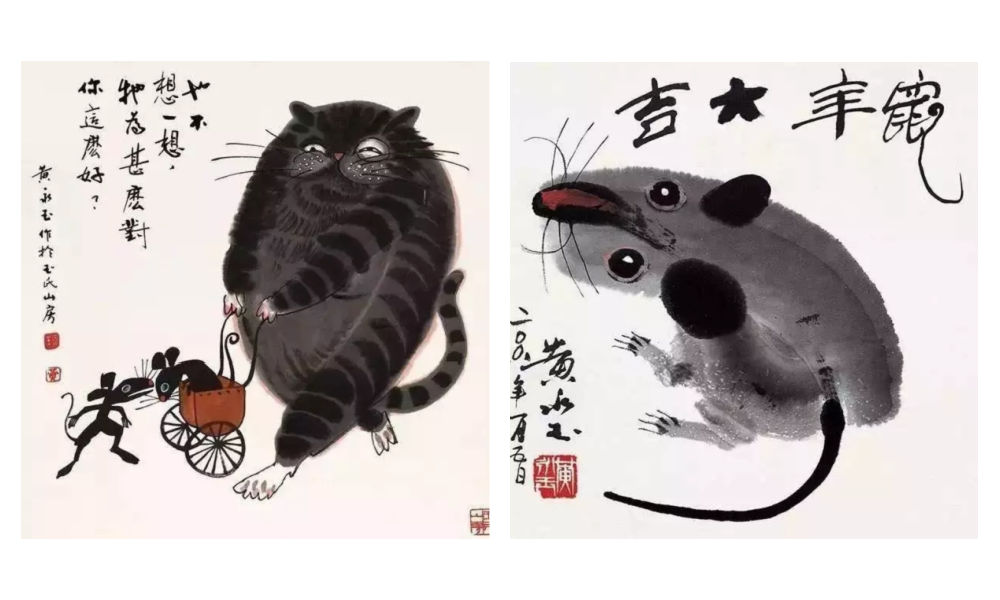
As a teacher, Huang liked to keep his lessons open-minded and he, who refused to join the Party himself, stressed the importance of art over politics. He would hold “no shirt parties” in which his all-male studio students would paint in an atmosphere of openness and camaraderie during hot summer nights (Andrews 1994, 221; Hawks 2017, 99).
By 1962, creativity in the classroom was limited and there were far more restrictions to what could and could not be created, said, and taught.
Bright Colors in Dark Times
“Strengthen my resolve and increase the fun of living”
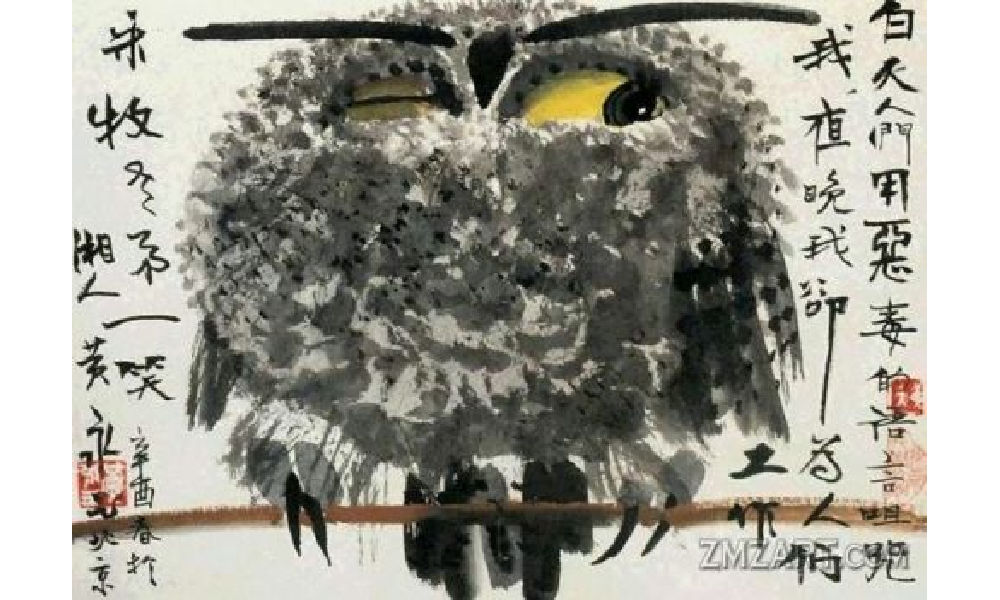
Huang Yongyu’s winking owl, 1973, via Wikiart.
In 1963, Huang was sent to the countryside as part of the “Four Cleanups” movement (四清运动, 1963-1966). Although Huang cooperated with the requirement to attend political meetings and do farm work, he distanced himself from attempts to reform his thinking. In his own time, and even during political meetings, he would continue to compose satirical and humorous pictures and captions centered around animals, which would later turn into his ‘A Can of Worms’ series (Hawks 2017, 99; see Morningsun.org).
Three years later, at the beginning of the Cultural Revolution, many Chinese major artists, including Huang, were detained in makeshift jails called ‘niupeng‘ (牛棚), cowsheds. Huang’s work was declared to be counter-revolutionary, and he was denounced and severely beaten. Despite the difficult circumstances, Huang’s humor and kindness would remind his fellow artist prisoners of the joy of daily living (2017, 95-96).
After his release, Huang and his family were relocated to a cramped room on the outskirts of Beijing. The authorities, thinking they could thwart his artistic pursuits, provided him with a shed that had only one window, which faced a neighbor’s wall. However, this limitation didn’t deter Huang. Instead, he ingeniously utilized vibrant pigments that shone brightly even in the dimly lit space.
During this time, he also decided to make himself an “extra window” by creating an oil painting titled “Eternal Window” (永远的窗户). Huang later explained that the flower blossoms in the paining were also intended to “strengthen my resolve and increase the fun of living” (Hawks 2017, 4; 100-101).
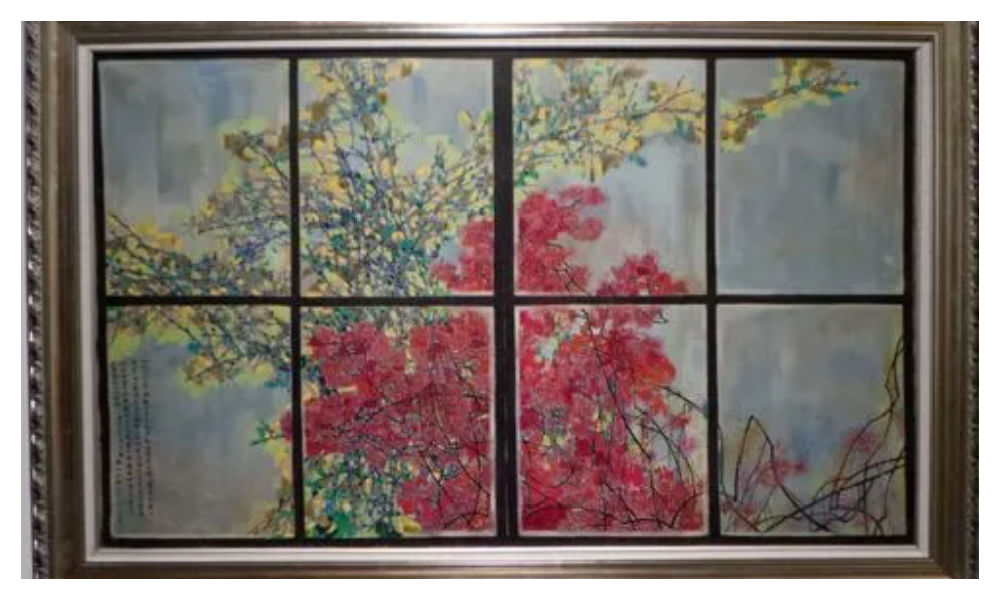
Huang Yongyu’s Eternal Window [Baidu].
In 1973, during the peak of the Cultural Revolution, Huang painted his famous winking owl. The calligraphy next to the owl reads: “During the day people curse me with vile words, but at night I work for them” (“白天人们用恶毒的语言诅咒我,夜晚我为他们工作”) (Matthysen 2021, 165).
The painting was seen as a display of animosity towards the regime, and Huang got in trouble for it. Later on in his career, however, Huang would continue to paint owls. In 1977, when the Cultural Revolution had ended, Huang Yongyu painted other owls to ridicules his former critics (2021, 174).
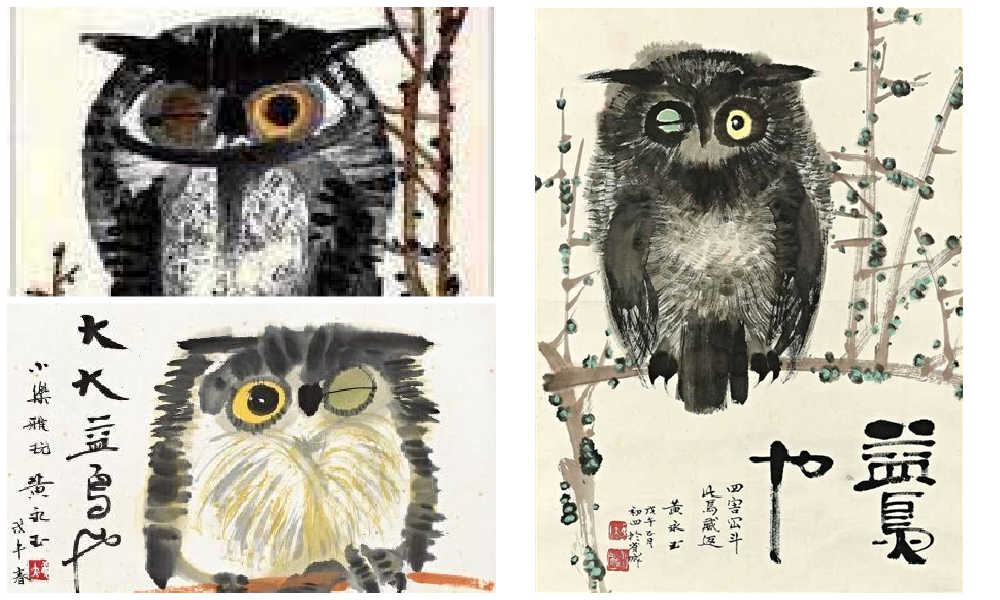
According to art scholar Shelly Drake Hawks, Huang Yongyu employed animals in his artwork to satirize the realities of life under socialism. This approach can be loosely compared to George Orwell’s famous novel Animal Farm.
However, Huang’s artistic style, vibrant personal life, and boundary-pushing work ethic also draw parallels to Picasso. Like Picasso, Huang embraced a colorful life, adopted an innovative approach to art, and challenged artistic norms.
An Optimist Despite All Hardships
“Quickly come praise me, while I’m still alive”
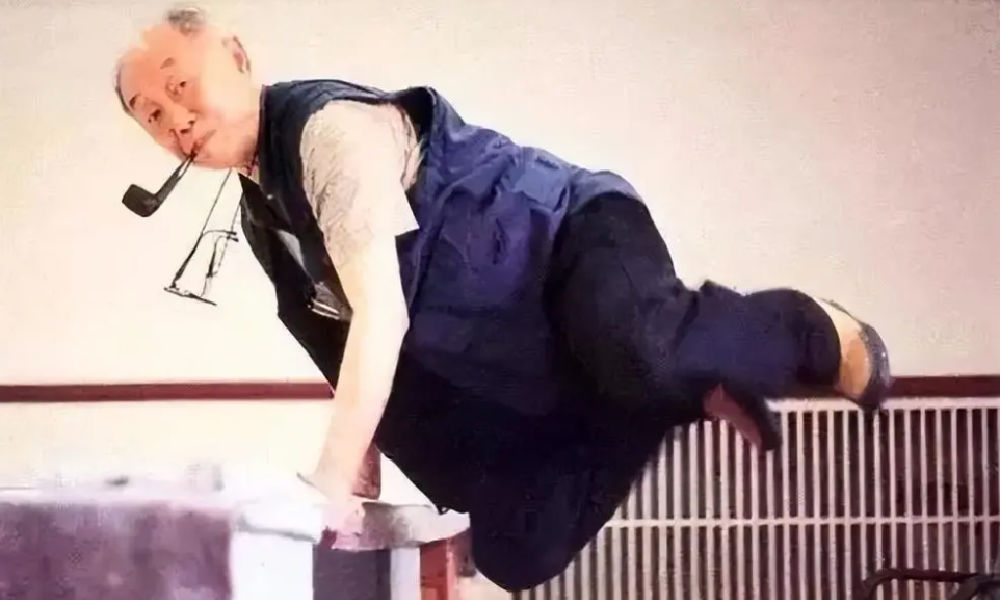
Huang Yongyu will be remembered in China with love and affection for numerous reasons. Whether it is his distinctive artwork, his mischievous smile and trademark pipe, his unwavering determination to follow his own path despite the authorities’ expectations, or his enduring love for his wife of over 75 years, there are countless aspects to appreciate and admire about Huang.
One things that is certainly admirable is how he was able to maintain a youthful and joyful attitude after suffering many hardships and losing so many friends.
“An intriguing soul. Too wonderful to describe,” one Weibo commenter wrote about Huang, sharing pictures of Huang Yongyu’s “Scenes of Pooping” (出恭图) work.
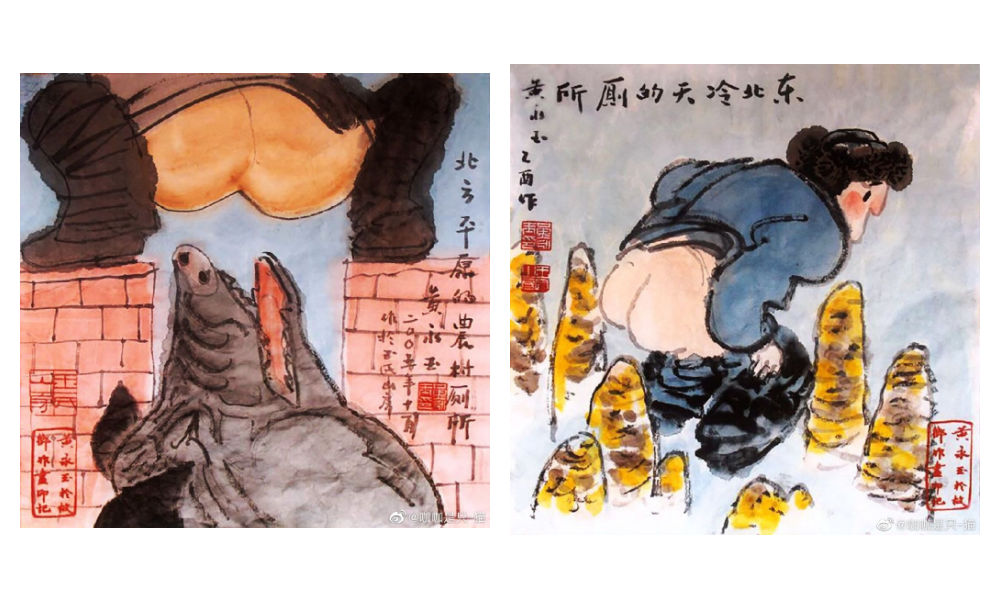
Old age did not hold him back. At the age of 70, his paintings sold for millions. When he was in his eighties, he was featured on the cover of Esquire (时尚先生) magazine.
At the age of 82, he stirred controversy in Hong Kong with his “Adam and Eve” sculpture featuring male and female genitalia, leading to complaints from some viewers. When confronted with the backlash, Huang answered, “I just wanted to have a taste of being sued, and see how the government would react” (Ora Ora).
I'm guessing the 98-year-old Huang loved the controversy. When confronted with backlash for his sculpture featuring male and female genitalia in 2007 Hong Kong, Huang answered, "I just wanted to have a taste of being sued, and see how the government would react." pic.twitter.com/kG0MVVM4SN
— Manya Koetse (@manyapan) June 15, 2023
In his nineties, he started driving a Ferrari. He owned mansions in his hometown in Hunan, in Beijing, in Hong Kong, and in Italy – all designed by himself (Chen 2019).
Huang kept working and creating until the end of his life. “It’s good to work diligently. Your work may be meaningful. Maybe it won’t be. Don’t insist on life being particularly meaningful. If it’s happy and interesting, then that’s great enough.”
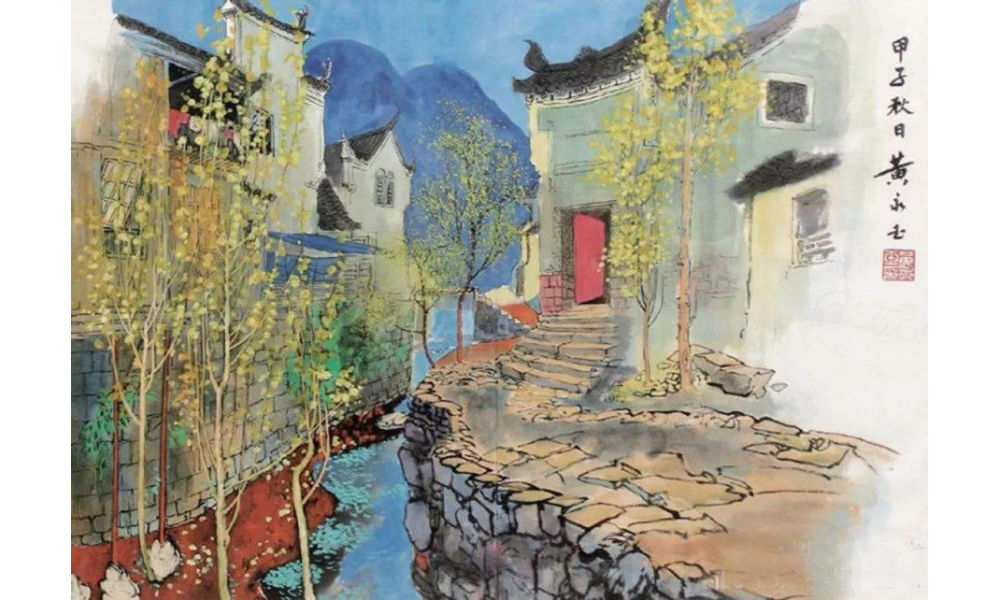
“Hometown Scenery” or rather “Hunan Scenery” (湘西风景) by Huang.
Huang did not dread the end of his life.
“My old friends have all died, I’m the only one left,” he said at the age of 95. He wrote his will early and decided he wanted a memorial service for himself before his final departure. “Quickly come praise me, while I’m still alive,” he said, envisioning himself reclining on a chair in the center of the room, “listening to how everyone applauds me” (CCTV, Sohu).
He stated: “I don’t fear death at all. I always joke that when I die, you should tickle me first and see if I’ll smile” (“对死我是一点也不畏惧,我开玩笑,我等死了之后先胳肢我一下,看我笑不笑”).
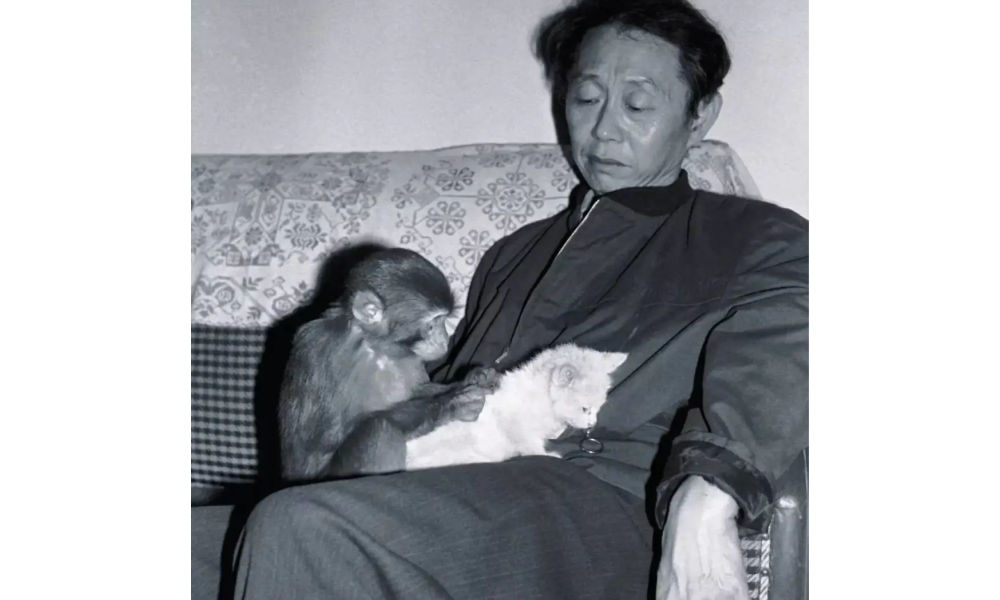
Huang with Yiwo (伊喔), the original model for the monkey stamp [Shanghai Observer].
Huang also was not sentimental about what should happen to his ashes. In a 2019 article in Guangming Daily, it was revealed that he suggested to his wife the idea of pouring his ashes into the toilet and flushing them away with the water.
However, his wife playfully retorted, saying, “No, that won’t do. Your life has been too challenging; you would clog the toilet.”
To this, Huang responded, “Then wrap my ashes into dumplings and let everyone [at the funeral] eat them, so you can tell them, ‘You’ve consumed Huang Yongyu’s ashes!'”
But she also opposed of that idea, saying that they would vomit and curse him forever.
Nevertheless, his wife expressed opposition to this idea, citing concerns that it would cause people to vomit and curse him indefinitely.
In response, Huang declared, “Then let’s forget about my ashes. If you miss me after I’m gone, just look up at the sky and the clouds.” Eventually, his wife would pass away before him, in 2020, at the age of 98, having spent 77 years together with Huang.
Huang will surely be missed. Not just by the loved ones he leaves behind, but also by millions of his fans and admirers in China and beyond.
“We will cherish your memory, Mr. Huang,” one Weibo blogger wrote. Others honor Huang by sharing some of his famous quotes, such as, “Sincerity is more important than skill, which is why birds will always sing better than humans” (“真挚比技巧重要,所以鸟总比人唱得好”).
Among thousands of other comments, another social media user bid farewell to Huang Yongyu: “Our fascinating Master has transcended. He is now a fascinating soul. We will fondly remember you.”
By Manya Koetse
Get the story behind the hashtag. Subscribe to What’s on Weibo here to receive our newsletter and get access to our latest articles:
References
Andrews, Julia Frances. 1994. Painters and Politics in the People’s Republic of China, 1949-1979. Berkley: University of California Press.
Baike. “Huang Yongyu 黄永玉.” Baidu Baike https://baike.baidu.com/item/%E9%BB%84%E6%B0%B8%E7%8E%89/1501951 [June 14, 2023].
CCTV. 2023. “Why Everyone Loves Huang Yongyu [为什么人人都爱黄永玉].” WeChat 央视网 June 14.
Chen Hongbiao 陈洪标. 2019. “Most Spicy Artist: Featured in a Magazine at 80, Flirting with Lin Qingxia at 91, Playing with Cars at 95, Wants Memorial Service While Still Alive [最骚画家:80岁上杂志,91岁撩林青霞,95岁玩车,活着想开追悼会].” Sohu/Guangming Daily March 16: https://www.sohu.com/a/301686701_819105 [June 15, 2023].
Hawks, Shelley Drake. 2017. The Art of Resistance Painting by Candlelight in Mao’s China. Seattle: University of Washington Press.
Matthysen, Mieke. 2021. Ignorance is Bliss: The Chinese Art of Not Knowing. Palgrave Macmillan.
Ora Ora. “HUANG YONGYU 黃永玉.” Ora Ora https://www.ora-ora.com/artists/103-huang-yongyu/ [June 15, 2023].
Spotted a mistake or want to add something? Please let us know in comments below or email us. First-time commenters, please be patient – we will have to manually approve your comment before it appears.
©2023 Whatsonweibo. All rights reserved. Do not reproduce our content without permission – you can contact us at info@whatsonweibo.com.
Subscribe

Weibo Watch: The Battle for the Bottom Bed

Zara Dress Goes Viral in China for Resemblance to Haidilao Apron

“Old Bull Eating Young Grass”: 86-Year-Old Chinese Painter Fan Zeng Marries 36-Year-Old Xu Meng

Chengdu Disney: The Quirkiest Hotspot in China

Where to Eat and Drink in Beijing: Yellen’s Picks

The ‘Two Sessions’ Suggestions: Six Proposals Raising Online Discussions

Top 9 Chinese Movies to Watch This Spring Festival Holiday

Party Slogan, Weibo Hashtag: “The Next China Will Still Be China”

From Pitch to Politics: About the Messy Messi Affair in Hong Kong (Updated)

“Old Bull Eating Young Grass”: 86-Year-Old Chinese Painter Fan Zeng Marries 36-Year-Old Xu Meng

Looking Back on the 2024 CMG Spring Festival Gala: Highs, Lows, and Noteworthy Moments

Two Years After MU5735 Crash: New Report Finds “Nothing Abnormal” Surrounding Deadly Nose Dive

More than Malatang: Tianshui’s Recipe for Success

Chengdu Disney: The Quirkiest Hotspot in China

In Hot Water: The Nongfu Spring Controversy Explained
Get in touch
Would you like to become a contributor, or do you have any tips or suggestions? Get in touch here!
Popular Reads
-

 China Insight2 months ago
China Insight2 months agoThe ‘Two Sessions’ Suggestions: Six Proposals Raising Online Discussions
-

 China Arts & Entertainment3 months ago
China Arts & Entertainment3 months agoTop 9 Chinese Movies to Watch This Spring Festival Holiday
-

 China Media2 months ago
China Media2 months agoParty Slogan, Weibo Hashtag: “The Next China Will Still Be China”
-

 China World2 months ago
China World2 months agoFrom Pitch to Politics: About the Messy Messi Affair in Hong Kong (Updated)




